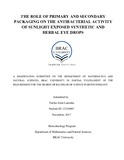| dc.contributor.advisor | Khan, Kashmery | |
| dc.contributor.author | Lamisha, Fariha Zerin | |
| dc.date.accessioned | 2018-01-21T05:45:31Z | |
| dc.date.available | 2018-01-21T05:45:31Z | |
| dc.date.copyright | 2017 | |
| dc.date.issued | 2017-12 | |
| dc.identifier.other | ID 13236003 | |
| dc.identifier.uri | http://hdl.handle.net/10361/9112 | |
| dc.description | This thesis is submitted in partial fulfilment of the requirements for the degree of Bachelor of Science in Biotechnology, 2017. | en_US |
| dc.description | Cataloged from PDF version of thesis report. | |
| dc.description | Includes bibliographical references (page 61-65). | |
| dc.description.abstract | Eye infections are considered as one of the most serious public health problem around the world, and are responsible for the blindness or visual impairment of about 1.9 million people every year. These Infection spreads through personal contact (via hands, clothes or bedding) and by flies that have been in contact with discharge from the eyes or nose of an infected person. As a protective measure the use of tropical ophthalmic solution is increasing. So, understanding the photo-stability and photosensitivity of these ophthalmic drugs are very important to treat eye diseases effectively. In the present study, the photo-degradation of sunlight treated and non- treated ciprofloxacin and herbal eye drops were compared in terms of their antibacterial activity against gram positive and gram negative bacteria. Ciprofloxacin and herbal eye drops manufactured by different companies were collected from local market and exposed to sunlight and their antibacterial activities were tested. Each eye drops was exposed to sunlight for ten hours in three different ways with secondary and primary packaging, primary packaging and transparent glass tubes. Antibacterial activity of synthetic and herbal eye drops was tested by well diffusion method against Staphylococcus aureus, Bacillus cereus, Salmonella typhi, Escherichia coli (STEC) and Proteus vulgaris. The result indicates a photo-degradation of ciprofloxacin eye drops which were turned into deep yellow color in primary and transparent glass packaging which might cause photo-toxicity, photo-allergenicity and other reaction of eyes. In contrast, the herbal eye drop did not show any color change. Significant differences in zone of inhibition were also observed among synthetic eye drops. However, herbal eye drops did not show any antibacterial activity against Bacillus cereus, Salmonella typhi, Escherichia coli (STEC) and Proteus vulgaris. The sunlight exposed eye drops showed decreasing photo-stability, so emphasis should be given to improve the manufacturing, packaging and storage systems of ophthalmic formulations. | en_US |
| dc.description.statementofresponsibility | Fariha Zerin Lamisha | |
| dc.format.extent | 81 pages | |
| dc.language.iso | en | en_US |
| dc.publisher | BRAC University | en_US |
| dc.rights | BRAC University thesis is protected by copyright. They may be viewed from this source for any purpose, but reproduction or distribution in any format is prohibited without written permission. | |
| dc.subject | Synthetic eye drops | en_US |
| dc.subject | Herbal eye drops | en_US |
| dc.subject | Antibacterial activity | en_US |
| dc.subject | Ciprofloxacin eye drops | en_US |
| dc.subject | Packaing | en_US |
| dc.title | The role of primary and secondary packaging on the antibacterial activity of sunlight exposed synthetic and herbal eye drops | en_US |
| dc.type | Thesis | en_US |
| dc.contributor.department | Department of Mathematics and Natural Sciences, BRAC University | |
| dc.description.degree | B. Biotechnology | |

